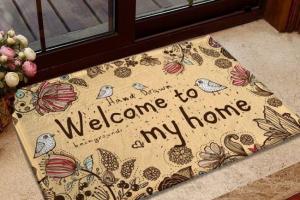Reviews of laminated doors are mostly positive, which is explained by their unusual design. A combination of materials is used in the production of such models, due to which they are distinguished by high quality and reliability. A wide variety of models ensures that every buyer will find a design that meets his requirements.
Why is lamination necessary?
This wood processing technology allows you to extend its service life. Its essence lies in the fact that the surface of the wood is covered with a special film on a machine, which is then fixed under the influence of a heating apparatus. Thanks to the resins contained in the film, it is ideally attached to the surface of the wood, so the doors have a presentable appearance. appearance. It can be matte, glossy, with different decorative effects, which allows you to choose a solution for any interior. The peculiarity of the film is that it reliably envelops even corners, which as a result looks solid and harmonious. can be supplemented with cutouts and inserts from other materials, glass, metal or stained glass.
Design Features
Laminated doors are reliable and durable, while they attract the attention of buyers at an affordable price. This is why laminated doors receive good reviews. Unique performance qualities and affordable prices are achieved minimum quantity natural materials and modern polymers at the same time. From a design point of view, these doors consist of several parts:
- Wooden frame. It is most often created from solid pine, which ensures its high quality and reliability. Laminated MDF doors are created from laminated veneer lumber in the form of scraps, interconnected using a special technology, thanks to which the final material is resistant to humidity and temperature changes. Many models are equipped with additional MDF strips interconnected by “honeycombs”. This allows you to achieve higher strength while maintaining low weight of the door structure.
- Filler. Its task is to promote additional heat and sound insulation. Most often, polyurethane foam and corrugated cardboard are used as filler.
- MDF overlays. They are created from compressed dust, combined into a single sheet using glue and subsequent pressing under high temperature. The overlay can be made of any shape and structure, it is glued to the frame.
- Protective and decorative layer. Doors veneered or laminated are covered with a specially thin decorative film, which is sometimes combined with a protective layer of laminate. The film is applied using a temperature-vacuum method.
Advantages
The combination of materials leads to the fact that laminated doors become durable and resistant to mechanical stress. It is these characteristics that are often noted by reviews.

Laminated interior doors have the following advantages:
- affordable cost;
- original appearance;
- a single-color pattern that is applied evenly;
- low weight of the structure;
- wide variety of models;
- resistance to temperature changes;
- environmental safety: it is no coincidence that these types of models are installed in medical institutions.
Flaws
Laminated doors received negative reviews due to several factors. For example, in customer reviews there is an opinion that good doors They are expensive, and cheap analogues will last 5-6 years at most. And here, it turns out, it’s not so much the material of the base of the door, but the quality of the laminate - a truly high-quality film is not cheap. The second unpleasant moment is the inability to restore the laminated coating if it has received severe damage. And the most weak link laminated structures - door frame, which is not thick enough and is easily deformed. This drawback is especially noticeable when installing such structures in the bathroom, when under the influence of moisture the frame bends over time and the door stops closing.
Veneer or laminate?
Any doors - veneered or laminated - attract attention with the thoughtfulness of every detail. At the same time, in terms of appearance and design, they are not much different, but the cost of veneered models is much higher.

If we compare these types of design, we can draw the following conclusions:
- High-quality laminated doors are resistant to high temperatures and humidity, and the protective layer is a solid polymer-based film that does not allow liquid to pass through. A veneered door cannot boast of such properties, as many reviews mention.
- Laminated doors are characterized by resistance to damage, although in reality it turns out that everything depends on the responsibility of the manufacturer and the quality of its products. In order not to make a mistake, you should trust trusted manufacturers.
- Easy care. It is much easier to care for structures covered with laminated film, since their surface is smooth and resistant to any abrasive agents.
Veneer or laminate: comparative characteristics
Are laminated or veneered doors better? This question is asked by many buyers. They have certain similarities. For example, the internal structure in both cases is made of wooden frame filled with honeycombs or wooden slats. Veneered models attract the attention of buyers with the unique structure of natural wood; even the grain pattern is preserved. However, the surface of such models darkens over time, and if the room is damp, the door may even crack. Laminate is an artificial material that is durable, resistant to mechanical damage and moisture. Caring for such doors is easy and simple, but if suddenly there are chips or scratches on the surface, they cannot be removed. All the features of both materials can be presented in table form:
Model | Advantages | Flaws |
Veneered door |
|
|
Laminated door |
|
|
Based on this table, you can easily understand which option is right for you.
What about the bathroom?

This room is one of the most capricious in our house, so you need to choose the method of finishing it wisely. You need to be especially careful when choosing a door. It is clear that the usual interior model will not fit here. Experts advise paying attention to laminated ones that meet several requirements:
- They are resistant to moisture and temperature changes.
- Do not deform during use.
Veneered models, which look more interesting and reliable, are not the best for the bathroom. the best choice because they are made of wood. They can only be installed in rooms where the exposure to moisture on the doors will be minimal. Besides important role plays a role in the quality of the varnish coating. It is cheaper and more reliable to purchase laminated bathroom doors.
There are several types of laminate doors:
- Models with paper base. Of course, you shouldn’t choose them for the bathroom, because very quickly the paper will become saturated with moisture and become deformed.
- Laminated doors with film on paper based, impregnated with special compounds, are more resistant to moisture, so they can be used in the bathroom. Thanks to the coating, the products are protected from moisture, but direct contact with water should still be avoided.
- Laminated bathroom doors received positive reviews as the most reliable option. Laminate is a material of polymer origin that is applied in a layer certain thickness and has excellent moisture resistance.
We decorate the rooms

As you know, laminated doors are an economical and, moreover, reliable solution for any room. The frame of these models is created on the basis of pine timber, and for filling they are used quality materials. All this makes laminated doors so popular among buyers original and reliable. The photo shows that all models have an interesting appearance, so it will be possible to arrange any interior. You need to choose models for interior design wisely:
- It is necessary to take into account the style decision in which a particular room is designed.
- You should not save money, because the longevity of its operation depends on the correct choice of a quality product.
- You need to think about the opening system. Modern doors laminated interior doors, reviews of which are most often good, are made in various versions of the opening mechanism. Most often, preference is given to those made with one or two canvases. If the room is small, you can give preference to sliding doors that fit harmoniously into any space. If the room is designed, for example, in country style, you can choose accordion doors.
Laminated interior doors received good reviews thanks to various options finishing. Lamination can be performed using different materials - wood, masonite, aluminum, paper-based plastic or fiberglass. Each model is original in its own way, and the choice of a specific material only affects the final cost of the model.

What to choose?
The modern market offers various laminated models. Laminated MDF doors reviews received good due to the affordable price and high quality of the models. The design of such models is simple and consists of a door frame filled with honeycombs, finished MDF panels and covered with laminate. Using MDF for cladding allows you to reduce the cost of models.
Plastic laminated doors are popular due to their high-quality finish. In their production, a two-chrome laminate or other durable material is used, which is additionally covered with a film imitation wood. Such interior doors have received a lot good reviews due to several factors:
- Excellent soundproofing properties.
- Strength.
- Fire safety.
- Ease of care.
- Resistance to mechanical stress.
- Durability of use.
All these characteristics make plastic laminated doors popular. The photo shows that these models can be made with glass inlay in different colors, which gives them original look. Such models will last a long time because they retain their shape even when used in high humidity conditions. Color and texture plastic doors will be preserved long time, so after installation you can long term forget about the possible replacement of the door system. It is important that such models are inexpensive.
Installation features
As already mentioned, laminated MDF interior doors receive mostly good reviews, as do plastic-based models. Regarding their installation, you need to remember some nuances. The most important thing that you should not forget about is the thin door frame, which can be deformed even under the influence polyurethane foam not too much high pressure. That is why the door frame must be attached to the opening with special corners. They are installed every 30 cm to avoid door deformation.

When installing laminated door products in the bathroom, you need to protect the frame from moisture. It is best to cover it with a special waterproofing film. In all other aspects, the door installation process is simple and straightforward. And remember that even with high-quality installation, laminated doors may not last very long, especially if you choose cheap models. Laminated doors received good reviews, but you should choose models wisely.
Lamination is a method of decorating the surfaces of fiberboards with a special film.
It is impossible to laminate a door at home!
Types of door lamination
There are two types of lamination:
- Melamine paper (thickness 0.2 mm). The chipboard is impregnated with resin and covered with film under high temperature and pressure. The method is cheap, but the quality of the coating is low.
- Laminate or artificial veneer (thickness 0.4-0.8 mm). Chipboard slabs are covered with laminated plastic and cold glued. The method is expensive, but the coating is of high quality.
During production, by pressing, decorative film becomes one whole, “grows” into the material on which it is applied, and enters into a chemical reaction with it. To carry out lamination, special equipment is required, and the process itself must be carried out under high pressure and temperature.
Typically, as an alternative to laminating doors yourself, self-adhesive film is used. This process is more reminiscent of the laminating method, from German - pasting, and is performed under “milder” conditions. Self-adhesive laminated film makes it possible to imitate the pattern of the canvas under any material (marble, wood, stone). It can be used to decorate slabs made of wood, chipboard, MDF, and metal. It must be said right away that it is possible to cover a door with film (at home), but the work looks handicraft.
Stages of door lamination
First we putty the surface of the board (chipboard). Using a spatula and putty, we remove all irregularities and dents door leaf. We rub the surface until it is perfectly smooth and prime it; if this is not done, then all the flaws will be visible on it. On back side The film contains a grid with centimeter increments - this makes it possible to accurately make a pattern. To work you need scissors, a knife, a pencil.
 Unwind the film, cut out a rectangle, leaving 3 cm at the edges for allowance for protrusions and margin. We remove the paper base from the edge of the film and fasten it to the edge of the door, carefully spread it over the surface, and at the same time pull out the backing. For better smoothing, blow hot air under the coating, use a regular hair dryer and smooth it from the center to the edge with a soft cloth. We pierce the formed bubbles. The most difficult thing is to carefully make the corners, end sides and places near the hinges. To do this, the material is cut along the edges at an angle of 45°, so it fits easier. Glue using a hairdryer or hot iron.
Unwind the film, cut out a rectangle, leaving 3 cm at the edges for allowance for protrusions and margin. We remove the paper base from the edge of the film and fasten it to the edge of the door, carefully spread it over the surface, and at the same time pull out the backing. For better smoothing, blow hot air under the coating, use a regular hair dryer and smooth it from the center to the edge with a soft cloth. We pierce the formed bubbles. The most difficult thing is to carefully make the corners, end sides and places near the hinges. To do this, the material is cut along the edges at an angle of 45°, so it fits easier. Glue using a hairdryer or hot iron.
To make the edges and corners look aesthetically pleasing, you can not bend the film, but carefully cut it with a knife, and glue the edge separately.
It is very important that the door does not cling to the frame anywhere, otherwise the coating will quickly peel off.
It is better to choose a monochromatic film so that there is no need to align the pattern, but if desired, you can choose one that imitates the texture of various materials.
No matter how hard we try, the homemade lamination will still be noticeably different from the factory one. It is difficult to cope without special equipment with film deformation due to temperatures and uneven fit of various roughnesses on the surface.
If you want to purchase high-quality products at an affordable price, contact DM-Service LLC. You will be offered a variety of models in different sizes, designs and colors.
Installation of laminated doors is modern solution for furnishing residential, office or utility rooms. The designs of such doors are varied, and each option has certain features that should be taken into account when choosing.
What are laminated doors
In the process of renovating residential or office premises, replacement of the door frame and leaf is often required. Among the variety of doors, laminated models are especially in demand. They may have a different internal structure, but the outside is always decorated with laminated film. Thus, the color of the doors can be any, but designs that imitate the structure of wood of different species are popular.
The internal filling of laminated doors can be different, but on the outside they are always decorated with laminated film
Laminated doors have a frame, which is often made of natural wood coniferous species. Also, the material for the frame can be chipboard (chipboard), but this option is typical for the cheapest doors. The internal filler can be made of extruded polystyrene foam or corrugated cardboard, and the outer layer is made of MDF (medium density fiberboard) and laminated film. Thus, laminated doors consist of several different materials, creating a beautiful and durable canvas.
Features of a laminated door
The frame with the filler, as well as the MDF layer and laminated film form the door leaf. The combination of natural and synthetic materials gives the product durability, practicality and reliability. The design of laminated doors has the following important features:
- MDF is covered with a thin film - laminate, which is fixed during production by hot pressing. Ends finished products decorated with a special edge tape, which gives the door a finished look and protects the door from moisture and deformation;
- a honeycomb core made of extruded polystyrene foam or corrugated cardboard provides sound and heat insulation. Therefore, laminated doors are practical to use and convenient for residential premises. Thanks to their honeycomb structure, such doors weigh much less than models made of natural wood;
- the door frame has a locking part where the lock and door knob. This area has a more reinforced frame than the other part of the canvas;
- the film protects the structure from deformation and gives the product an aesthetic appearance. For laminated doors, the following coating options can be used:
- two-chrome laminate;
- polyvinyl chloride film (PVC);
- multilayer impregnated paper;
- paper-based film 0.2 mm thick.
Laminated doors differ from veneered ones only in the outer coating
The main difference between laminated structures and veneered ones, which are another popular option, is the type of external coating used. Laminate film is a colored coating on a polyvinyl chloride or paper base, and veneer is a thin layer of wood coated with a colored layer and various protective compounds.
Types of laminated doors
When choosing a laminated door, it is best to focus on the following product characteristics:
- Type of laminated coating: service life, resistance to mechanical stress and humidity, and the appearance of the door depend on it.
- Construction design: it should correspond to the overall design of the environment, and the color palette should correspond to the tone in which the room is decorated.
- Thickness, width and height of the door: dimensions are determined depending on the parameters of the opening into which the structure will be installed, taking into account the frame.
- Defects: swelling, cracks and other damage should not be present on the surface of the product.
A properly selected laminated door will last for many years without repair.
Classification by type of door leaf
Based on the type of door leaf, laminated doors can be divided into 2 types: solid and glazed.
Solid laminated doors
Solid-type doors are a panel without glass inserts, carved or figured elements. Often such products are presented in the form of a flat canvas, but they can also have simple decorative elements. Blind laminated doors look laconic and strict, and smooth surface may have a light relief that imitates the structure of wood.
Solid laminated doors will easily fit into any interior
Solid laminated doors are characterized by higher sound insulation than models with glass inserts. A smooth or slightly embossed surface makes the door universal for any interior style. The parameters of blind doors can be different, which allows you to choose a design for any opening. Products most often have a rectangular shape, but there are also arched versions.
Doors with laminated film can be of any color
The positive aspects of blind doors:
- increased strength compared to structures with inserts;
- high sound insulation;
- greater level of reliability and durability than glass products;
- laconic and strict design.
Laconic doors are practical and convenient for residential premises
A negative feature of blank canvases is that scratches, cracks and other damage are more visible on them. This leads to the need to repair or even replace the door.
Glazed laminated doors
Glazed doors are products consisting of a frame and glass. The shape of glass inserts can be rectangular or shaped.
Glass inserts can have both a decorative and practical function: for example, transmit light from a room into a dark corridor
Most often, glazing in doors is used exclusively in decorative purposes. But the glass in the door leaf can also play a practical role: the transparent insert is used as a source of additional lighting in a room without windows. Laminated doors with glass fit into almost any setting. They unite space and create the illusion of lightness and airiness.
Glass inserts in interior doors add lightness to the interior
Glass in a laminated door can be:
- transparent;
- matte;
- corrugated;
- colored;
- with an image.
For decoration, you can use stained glass film, which will not only decorate the door leaf, but also make the glass more durable
The disadvantages of glazed laminated doors include low thermal insulation characteristics and poor sound insulation.
Types of doors by material
There are several types of laminated doors, which differ in the material used in the manufacture of the product. Each variety has certain characteristics.
Laminated MDF doors
The design of an MDF door has a classic structure, which involves the presence of a frame, filler, and outer leaf. A distinctive feature of such a door is that the outer leaf is made of slabs, which are thick cardboard of a coarse fraction. This material is obtained by pressing at high temperatures and using adhesive composition. The outside of the canvas is covered with a film, which can be PVC or paper based.
MDF is a rough and thick cardboard covered with film
Doors made of MDF are lightweight and low cost. It makes them budget option, but it is worth considering the low resistance of the material to humidity, mechanical stress and active use. The color palette is very extensive, since there are many options for films that cover the outer MDF sheet.
MDF can be covered with a smooth or matte film, as well as with a corrugated film that imitates the surface of natural wood
Lightweight and comfortable MDF structures have the following advantages:
- easy maintenance that does not require the use of special cleaning agents;
- easy installation and assembly of the structure directly at the installation site;
- wide palette of shades, pleasant to the touch surface structure;
- light weight, the ability to install any locks and door handles.
Laminated doors can be decorated in different styles, for example, in the Rococo style, which is characterized by an abundance of gold details and pastel colors
Upon purchase quality doors from MDF, it should be taken into account that paper-based film, which is a common option, is not very durable. Under conditions of normal indoor humidity, as well as careful operation and proper care such doors will last more than 10 years. Otherwise, there is a high probability of film peeling, door swelling, and deformation of the frame and leaf.
Plastic laminated doors
Laminated doors coated with PVC films are called plastic and may have glass inserts, various decor or other design. They can be sliding, double-leaf, classic swing or arched. Manufacturers also produce doors in the form of an accordion or book and other options.
The design of plastic laminated doors is more varied than the design of other door options
The main characteristic of plastic laminated doors is the higher strength of the coating, since the film is made of PVC. A varied color palette and many design options will make it easy to choose a product for any room. The service life of plastic laminated doors is also longer than that of paper-coated models.
Laminated chipboard doors
Chipboard (chipboard) is often the basis for the manufacture of laminated doors. This material is made from wood chips with the addition of binders, water-repellent and other components. Thanks to the use of large chips, chipboard has a pronounced structure and has higher technical characteristics than MDF.
Experts say that chipboard is more durable than MDF
home feature of chipboard expressed in high strength, which makes the structures durable and reliable. The content of antipyrines, water-repellent, and powerful binding components in the structure ensures the material’s resistance to humidity, temperature changes and active use.
Externally, doors made of chipboard differ little from products made of MDF
Chipboards covered with laminated film are called laminated chipboards. This material serves as the basis for the outer covering of doors. Due to its strength and other characteristics, laminated chipboard has the following advantages:
- resistance to impacts, cracks, scratches;
- variety of shapes and colors of doors;
- affordable price.
Doors and furniture made of laminated chipboard go well with each other
Despite their strength, laminated chipboard doors are not sufficiently resistant to high humidity. With constant exposure to water, the material can deform and swell, then the doors will lose their beautiful appearance and will be inconvenient to use.
Popular colors of laminated doors
Thanks to the use of various films, laminated doors can be of any color. Classic shades are wenge, milky oak, Milanese walnut and beech. The names of the shades reflect the color of natural wood for which the imitation was created. Regular colors are also relevant, for example, classic white, black, burgundy and other options.
Depending on the manufacturer, the exact names of the shades of the laminated film may differ
Features of installation and operation of doors
Laminated doors can be made to order from the manufacturer or purchased in a store. In the first case, the product best suits the individual requirements of the customer, and in the second, you need to carefully select doors depending on the characteristics of the room, design, and personal preferences. But whatever the choice, in any case you can install the structure yourself.
For work you will need screws 3.5x25, 3.5x65, 4.2x90, 3.5x51. The required tools are a tape measure, building level, square, screwdriver, foam in a gun.
Main stages of door installation
- The doorway is prepared by removing old door. Then you should align the edges of the door slopes.
From the top and bottom from the edge of the door to the hinges you need to retreat approximately 20 cm
- Next, hang the canvas on the hinges, check the evenness with a square and, if necessary, adjust rubber mallet by slightly moving the frame or door. After this, the gaps between the wall and the box are treated with polyurethane foam, and the door lock, install additional elements and cashing.
After drying, the pieces of polyurethane foam are cut flush with the wall.
How to repair laminated doors
Laminated doors in residential or office premises are subjected to intensive use, resulting in breakdowns. In most cases, experts recommend replacing old structures with new ones, but sometimes you can repair or even restore doors yourself. This is possible in the following common situations:
- small holes, scratches, cracks in the coating can be easily corrected using furniture wax and a special furniture marker. The color is selected depending on the shade of the door, scratches are carefully painted over, hiding their presence;
- the peeling edge must be carefully removed, a new edge tape must be purchased to match the color of the old one, and it must be attached in place of the peeled one, smoothing it with a hot iron;
- if the door is sagging, then you need to tighten the screws of the hinges, adjusting the desired height;
- If a door lock or handle breaks, they must be replaced with new ones, carefully removing the old ones.
Scratches can be easily painted over with a furniture marker
If the main part of the door leaf is swollen and covered with bubbles, then it is impossible to repair such a structure. Similar consequences occur due to high humidity. The peeling of the paper film on the main panel can be corrected by applying PVA glue to the damaged area with a brush, but such a measure is only temporary, and the door will still need to be replaced.
Video: removing scratches with a furniture touch
How to care for laminated doors
Doors of this type are budget-friendly and do not have too much long term service compared to structures made of natural wood. The service life can be extended only if the simple rules product care.
- Water is the main enemy of laminated doors. Do not wash the fabric with a wet cloth or sponge; you must use polish, wax and other cleaning products intended for furniture.
- The film doesn't hold up strong blows, and therefore careful operation is important.
- If you do not correct the canvas, which touches the box when closing, the edge tape may peel off and other defects will appear.
- Do not rub the surface with hard, metallic, rough sponges, as visible scratches will immediately appear on the film.
- For installation in rooms with high humidity (bathroom, toilet, kitchen) it is best to choose wooden doors or high quality laminated chipboard structures.
- Squeaky hinges should be lubricated by special means, for example, universal lubricant WD-40, and the application of such products should be spot-on.
Apply hinge lubricant carefully so that the product does not get on the laminated surface
Currently everything more people began to opt for laminated doors. They cost much less than others, and this is the main selection criterion. In addition, the laminating film covering the door leaf protects it from various damages, high humidity and is resistant to aggressive chemicals.
If you accidentally spill a glass of water on the door, you should not worry about it damaging the surface. Simple enough wipe the surface with a dry cloth. One more important advantage laminated doors is that they are not subject to deformation. To do right choice, you need to figure out what this design is.
What is it - laminated doors
This design is a frame that consists of pine bars and filled with pressed cardboard honeycombs. The result is a very strong and reliable design. Such a frame is lined with MDF boards and covered with a laminating film, which is artificial material, produced in an extremely wide range color palette. This makes it easy to choose doors that would harmoniously combine with the furniture, floor covering and the color of the walls.
Modern technological equipment allows produce laminated doors high quality that can compete with other types of doors. The pattern produced on the film quite accurately imitates different breeds wood
What is laminating film
This film is made using different technologies. She there are several types:

Laminate is great imitates any material, mainly wood, but it can be stone, metal or plant motifs. The surface of a laminate door can have a pattern or be completely smooth.
 The door structure received this name due to the coating applied to its surface. protective material. Modern laminate doors, with their characteristics, are in no way inferior to door structures made from solid natural wood, and in some cases even surpass them.
The door structure received this name due to the coating applied to its surface. protective material. Modern laminate doors, with their characteristics, are in no way inferior to door structures made from solid natural wood, and in some cases even surpass them.
Production technology is quite simple, which allows them to be produced in a large assortment. The laminate door structure consists of solid pine or bars. In the first option, the frame is covered with fiberboard or MDF boards, and in the second option, the space inside the frame is filled with honeycomb cardboard, and MDF is attached on top. A decorative laminate is glued on top of the facing sheets. Combination technological process with the material ensures the production of low-cost doors.
Laminate protects the door leaf from mechanical damage and high humidity. This allows us to come to the conclusion that you should not save much and purchase doors with paper-based film. They produce such door designs using synthetic resins, but they do not cause any harm to the human body and can be installed even in children's and medical institutions.
Advantages and disadvantages of laminated doors
Such products may have both pros and cons.
Advantages:

Flaws:
- Lack of variety in design. This is considered a conditional flaw. Many people even like the fact that the doors are similar to each other. However, soon this disadvantage will disappear completely, because more and more complex designs have begun to go on sale.
- Damage to the film, such as cracking or blistering. Cracking of a material means its divergence at the joints and the formation of cracks and crevices. The film swells due to the fact that it begins to peel off from the base material of the door.
- Low mechanical strength of a door structure with a cardboard base. Such doors are never strong, because they are very light and can easily be broken through with your foot. Doors with a chipboard frame are much heavier, but therefore stronger.
- Low environmental friendliness. Manufacturers of these door designs They declare with confidence that this is an absolutely environmentally friendly material, but it will never compare with natural wood. Interior products and the film that covers it contain a variety of synthetic impregnations. Chemicals evaporate mainly from the inside. Since lamination guarantees complete sealing, odors can enter the room through the hole for the handle or lock.
- Repairing a laminated door is very difficult. Traces of damage will definitely be noticeable.
 Although this design is unpretentious in maintenance, it can last a long time only if take proper care of her. It is advisable to protect it from exposure high temperatures and mechanical damage.
Although this design is unpretentious in maintenance, it can last a long time only if take proper care of her. It is advisable to protect it from exposure high temperatures and mechanical damage.
The laminated surface should be regularly treated with a polish, preferably containing wax. This helps give the door a beautiful gloss and disguises microcracks. If such a structure is installed in a room with normal humidity, then it must be treated twice a year.
Once a year it should be removed from its hinges to process mechanical parts and clean hard to reach places. It is not recommended to clean laminate surfaces with abrasives, as they can damage it.
When caring for laminated doors, you should not use chemicals, which are not intended for them. Although the laminate is quite resistant to the effects of such agents, there is a high probability that a chemical reaction will occur when the coating interacts with the components of the cleaning composition, as a result of which it will begin to deteriorate.
The most the best remedy, intended for the care of laminated surfaces, is considered a solution of water and alcohol in a ratio of 9:1. The doors must be wiped with this composition once a year.
In the process of wiping the structure, it is necessary Special attention pay attention to the door frame, the bottom of the door leaf and trim. During wet cleaning, these areas are most susceptible to negative influence moisture. A diluted dishwashing liquid or soap solution works great as a cleaning agent.
If cracks or chips have formed on the laminated surface, you can disguise them using a wax pencil. The wax must be heated and applied to the damaged surface, then polished with a soft cloth.
If the laminate becomes damaged or begins to peel due to temperature or mechanical stress, do not attempt to eliminate this defect on one's own. All the same, it will not be possible to do this efficiently, so you need to use the services of specialists who, using special equipment, will eliminate all problems.
How to choose the right laminated door
No matter how carefully you take care of such a design, if the product is of low quality, then after a while it will present an unpleasant surprise. To make the right choice, you should pay attention to the following points:

Conclusion
are very popular. High-quality models are covered with a film that remarkably protects the product from various adverse influences. Cheap designs are not as durable and fail very quickly. So it is best to purchase high-quality laminated doors that will serve faithfully for many years.
Laminated doors belong to the budget class of interior doors. Affordable price has led to their wide distribution, however, good, high-quality laminated doors may not be so cheap - there are also price gradations in the laminated door segment itself.
Many manufacturers of laminated doors position their products almost as the pinnacle of elegance, ease of use, and sometimes even environmental friendliness. Sellers always tend to praise their goods, but our task is to understand everything impartially, which is not so easy.
First of all, you need to obtain a set of minimal knowledge about the structure of laminated doors. Most characteristics are determined by two factors - the film, which is responsible for withstanding minor mechanical impacts, resistance to abrasion, fading under ultraviolet radiation, exposure to chemical substances, and door designs, which are covered with film completely or in the form individual elements. The design determines the weight and overall strength of the doors. Let's start with the types of film.
Film
What is laminate (laminatin)? The answer, it would seem, is known to everyone - this is a film that covers all kinds of products, in our case doors. Everything is true, but there is different classes and types of film. This can be a layer of paper and cellulose fiber impregnated with synthetic resins - melamine film, or it can be a more expensive option - PVC (polyvinyl chloride) or a durable two-chrome laminate. The difference is very significant - it is clear that it is difficult to call paper (even with impregnation) as a coating and a coating.
The film is very important factor. On the Internet you can find many opposing opinions about laminated doors - in one case it is claimed that they are moisture resistant, in another - that they are afraid of water and can only be carefully wiped with a damp cloth; someone claims excellent abrasion resistance, another writes that the door is very easy to damage: he bought it, they say, and immediately scratches appeared. Confusion arises - after all, everywhere we are talking about laminated doors.
In fact, there is no confusion - all statements are true for different types films
Another point that may cause confusion is that the term “PVC doors” is often found on the Internet. An equally common question is which is better - laminated doors or PVC doors. The latter are usually positioned as the best, but in fact the question is a little incorrect.
Firstly, PVC doors are covered with PVC film (using a membrane-vacuum press, hot pressing or other method). That is, laminated. And it turns out that you need to compare types of film, and not types of laminated doors.
It is also incorrect that lamination with paper is usually compared with lamination with durable PVC film. Of course the latter is better!
In order to understand what’s what in such conversations and debates, we list the types of films with brief characteristics.
- Paper-based film is the most inexpensive option. The thickness of the coating is about 0.2 millimeters and it is clear that there is no need to talk about any strength of such lamination - chips or scratches can appear even from minor mechanical impacts. Laminated doors with such a film can fade in the sun, become wrinkled when humidity appears, and there is no need to talk about resistance to chemicals. The process of gluing the film is called laminating (in most cases, the film is glued to MDF), which is why such doors are sometimes called laminated. Let us note, by the way, that many do not consider lamination to be lamination and there is logic in this.
- Multi-layer paper impregnated with melamine resin costs more high level. Impregnation gives the paper some qualities characteristic of plastic films - sometimes in descriptions it is positioned as multilayer plastic.
Interior doors with such a coating have a certain resistance to changes in humidity, some chemical influences, and are not subject to fading under sunlight, they are quite durable and retain their original appearance for a long time.
The disadvantage of melamine doors is the melamine resin itself - there are many descriptions on the Internet that directly state that melamine film is poisonous. But at the same time, everything is being discussed at the level of rumors. Yes, melamine itself is toxic, but the danger of its content in interior doors not confirmed by statistical data (at the time of writing). Nevertheless, this factor is worth taking into account. - PVC film is made from polyvinyl chloride compounds, a polymer material widely used throughout the world. Laminated doors with PVC coating are very common because they have good attitude prices to user specifications. PVC doors do not fade in the sun, resist changes in humidity and most household chemical compounds. The thickness of the film usually ranges from 0.2-0.5 millimeters. Exist different versions PVC doors, up to almost complete wrapping in film. One can argue about whether this is good or bad - the door still needs to breathe. But for wet areas best option can not found.
Laminated PVC doors are available in a variety of color and design solutions from various manufacturers. - Two-chrome laminate is one of the most durable and practical types of coating for laminated doors. This is a polymer film, the thickness of which ranges from 0.4-0.8 mm. Doors laminated with such a film, as already mentioned, are more expensive, but they have many wonderful qualities. They are not afraid of changes in moisture, exposure to sunlight, have a beautiful appearance and do not lose it, they have excellent resistance to abrasion and chemicals. Finally, they have excellent resistance to mechanical stress. Due to its external resemblance to natural veneer, double-chrome laminate is sometimes called artificial veneer.
Very often, manufacturers use several different types of films - the edges of doors, for example, are covered with PVC film, and the door leaf with melamine laminate.
The next question is how laminated doors are made and what is inside such doors.
What's inside laminated doors
As already mentioned, in most cases laminated doors occupy the lowest price segment. This leads to the inevitable conclusion - the insides of the doors are made from wood waste. This can be chipboard, MDF and other various fractions.
In most cases, a laminated door consists of a frame made from the cheapest wood (usually pine), into which panels from the above waste materials are inserted. The cheapest option is cellular type filling ( hollow structures made of cardboard in the form of honeycomb cells). Various combinations of these options are possible, using extruded polystyrene foam as a filler, but the essence will not change - in most cases these will be the cheapest materials (in comparison with solid natural wood).

One of the design options for good laminated doors
(sketch taken from the manufacturer's website).

The most simple design
laminated doors
Now, understanding what's what, we can list the advantages and disadvantages of laminated doors. Obviously, the description of the structure is cursory and superficial, but for our purposes it will suffice.
Advantages of laminated doors
Cheapness
An undeniable advantage, but we know how it is achieved.
Nature conservation
The filling of the laminated door leaf is usually made from waste, rather than trees purposefully cut down for this purpose.
Light weight
In most cases, the inside of laminated doors is a honeycomb structure - the material is very light. But the light weight of the door is still good characteristic. Doors with light weight can be easily removed from their hinges (if the design of the hinges allows), they will not slam in a draft so much that the door frame will fly out. In the end, you can’t even really slam them during a family quarrel :-).
High moisture resistance
With a high-quality PVC film and good vacuum sealing, this is truly an advantage - the door, with some stretch, can be called airtight. In the case of paper films, we cannot talk about any moisture resistance.
Cleans well
Laminated doors are good and easy to clean. The statement is true for doors with high-quality film. The cost of such doors will be significantly higher, thus reducing the advantage in the form of price. But such doors are worth it.
Fairly high resistance to point force impacts
And this statement is true for high-quality doors and good film - PVC or double-chrome laminate. A trivial example is to take a small metal object and press hard on pine doors. In most cases there will be a small hole or dent - pine is very soft. High-quality films are durable and it is difficult to imagine the appearance of dents under the same force.
This is where the advantages of laminated doors end, let’s look at the disadvantages.








